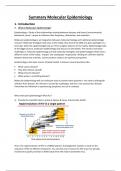Summary
Summary of molecular epidemiology of infectious diseases 2048FBDBMW (17/20)
- Course
- Institution
This is a summary of the course molecular epidemiology of infectious diseases from the master infectious and tropical diseases. It contains class notes and exercises.
[Show more]



